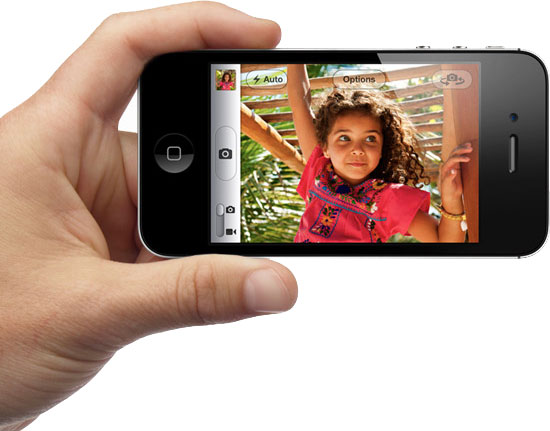
Here it is folks, the iPhone 4S from Apple. It's not the iPhone 5 like so many people were expecting, or at least hoping Apple would unveil. You won't find any obvious outwardly design changes, like a bigger screen or a redesigned chassis. Even the back is still covered with glass, ready to dole out instant punishment to the poor sap who carelessly loses his grip and lets his phone fall to the floor. The iPhone 4S doesn't drive a stake in the heart of Android or Windows Phone 7, and it won't change the world in the same fashion that the original iPhone did back in 2007. These are all the things that the iPhone 4S isn't. The obvious question to ask at this point is, what
is the iPhone 4S?
The iPhone 4S is first and foremost the last iPhone model to come out of Cupertino under the tutelage of the late, great Steve Jobs. It's as much his product as any previous iPhone device -- his sooner than expected swan song, if you will, even though it was Tim Cook who took center stage at Apple's recent "Let's Talk iPhone" event. This is the flagship phone Jobs felt confident could compete with all those newfangled Android phones boasting big screens and dual-core processors.

Well, the iPhone 4S doesn't have a bigger screen than before, or even one that's particularly large, but it does finally sport a dual-core Apple A5 processor, the exact same CPU Apple stuffed inside the iPad 2 (just clocked a little slower). Apple outfitted the camera in the iPhone 4S with all-new optics, which is now better equipped to capture memories in low light situations and can record 1080p video. It has a built-in "virtual personal assistant" that's fantastically creepy in how well it works, and it's ready to get jiggy with three wireless carriers (AT&T, Verizon, and Sprint). But do these upgrades make the iPhone 4S all that and a bag of apples? Let's find out.
 |
| Apple iPhone 4S vs iPhone 4 |
| Specifications & Features |
|
|
Apple iPhone 4S
|
Apple iPhone 4 |
| CPU Speed |
Apple A5 CPU
|
Apple A4 CPU
|
| Platform |
iOS 5
|
iOS 5
|
| Memory |
Flash 16GB/32GB/64GB + 512MB RAM |
Flash 16GB/32GB/64GB + 512MB RAM
|
| Dimensions (LxWxT) |
4.5 (H) x 2.31 (W) x 0.21 (D) inches
|
4.5 (H) x 2.31 (W) x 0.27 (D) inches
|
| Weight |
4.9 ounces (140 grams)
|
4.8 ounces (137 grams)
|
| Display |
3.5-inch Retina display with 960x640 resolution; 326pp; Multi-Touch; 800:1 Contrast Ratio; 500 cd/m2 max brightness (typical); Fingerprint-resistant oleophobic coating on front and back |
3.5-inch Retina display with 960x640 resolution; 326pp; Multi-Touch; 800:1 Contrast Ratio; 500 cd/m2 max brightness (typical); Fingerprint-resistant oleophobic coating on front and back |
| Network |
Quad-band UMTS/HSDPA/HSUPA (850, 900, 1900, 2100 MHz) + GSM/EDGE (850, 900, 1800, 1900 MHz) + CDMA EV-DO Rev. A (800, 1900 MHz)
|
Quad-band UMTS/HSDPA/HSUPA (850, 900, 1900, 2100 MHz) + GSM/EDGE (850, 900, 1800, 1900 MHz) + CDMA EV-DO Rev. A (800, 1900 MHz) |
| Onscreen Navigation |
All touchscreen |
All touchscreen |
| GPS |
Internal GPS antenna |
Internal GPS antenna |
| Sensors |
Three-axis gryro; Accelerometer; Proximity sensor; Ambient light sensor
|
Three-axis gryro; Accelerometer; Proximity sensor; Ambient light sensor |
| Connectivity |
Bluetooth 4.0; 802.11b/g/n Wi-Fi; 3.5mm stereo audio jack; Apple Dock connector |
Bluetooth 2.1; 802.11b/g/n Wi-Fi; 3.5mm stereo audio jack; Apple Dock connector
|
| Camera |
8-megapixel rear-facing
- Autofocus
- Tap to focus
- Face detection in still images
- LED flash
- Video recording, HD (1080p) up to 30 frames per second with audio
- Video stabilization
Front camera with VGA-quality photos and video at up to 30 frames per second
|
5-megapixel rear-facing
- Autofocus
- Tap to focus
- LED flash
- Video recording, HD (720) up to 30 frames per second with audio
- Video stabilization
Front camera with VGA-quality photos and video at up to 30 frames per second
|
Audio
Formats |
AAC (8 to 320 Kbps); Protected AAC (from iTunes Store); HE-AAC; MP3 (8 to 320 Kbps); MP3 VBR, Audible (formats 2, 3, 4, Audible Enhanced Audio, AAX, and AAX+); Apple Lossless; AIFF; and WAV |
AAC (8 to 320 Kbps); Protected AAC (from iTunes Store); HE-AAC; MP3 (8 to 320 Kbps); MP3 VBR, Audible (formats 2, 3, 4, Audible Enhanced Audio, AAX, and AAX+); Apple Lossless; AIFF; and WAV |
Video
Formats |
H.264 video up to 1080p, 30 frames per second, High Profile level 4.1 with AAC-LC audio up to 160 Kbps, 48kHz, stereo audio in .m4v, .mp4, and .mov file formats; MPEG-4 video up to 2.5 Mbps, 640 by 480 pixels, 30 frames per second, Simple Profile with AAC-LC audio up to 160 Kbps per channel, 48kHz, stereo audio in .m4v, .mp4, and .mov file formats; Motion JPEG (M-JPEG) up to 35 Mbps, 1280 by 720 pixels, 30 frames per second, audio in ulaw, PCM stereo audio in .avi file format |
H.264 video up to 720p, 30 frames per second, Main Profile level 3.1 with AAC-LC audio up to 160 Kbps, 48kHz, stereo audio in .m4v, .mp4, and .mov file formats; MPEG-4 video, up to 2.5 Mbps, 640 by 480 pixels, 30 frames per second, Simple Profile with AAC-LC audio up to 160 Kbps per channel, 48kHz, stereo audio in .m4v, .mp4, and .mov file formats; Motion JPEG (M-JPEG) up to 35 Mbps, 1280 by 720 pixels, 30 frames per second, audio in ulaw, PCM stereo audio in .avi file format |
| Battery |
Talk Time: Up to 8 hours on 3G, up to 14 hours on 2G (GSM model only); Standby Time: Up to 200 hours; Internet Use: Up to 6 hours on 3G, up to 9 hours on Wi-Fi; Video Playback: Up to 10 hours; Audio Playback: Up to 40 hours
|
Talk Time: Up to 7 hours on 3G, up to 14 hours on 2G (GSM model only); Standby Time: Up to 300 hours; Internet Use: Up to 6 hours on 3G, up to 10 hours on Wi-Fi; Video Playback: Up to 10 hours; Audio Playback: Up to 40 hours |
| Expansion Slot |
None |
None |
| In-Box Content |
Main unit; Apple Earphones with Remote and Mic; Dock Connector to USB Cable; USB Power Adapter; Documentation |
Main unit; Apple Earphones with Remote and Mic; Dock Connector to USB Cable; USB Power Adapter; Documentation |
|
We already covered the main differences, but there are a few other things that separate the iPhone 4S from its predecessor. Apple claims you'll squeeze an extra hour of talk time out of the iPhone 4S on 3G, but standby time has been reduced to 200 hours. Internet use on Wi-Fi is down by an hour (up to 9 hours on Wi-Fi compared to up to 10 hours), and the weight and dimensions are slightly different too, though nothing to lose your shorts over.
Available in both black and white, pricing is unchanged for a flagship iPhone. It costs $199 for the 16GB model, $299 for 32GB, and $399 for 64GB, assuming you sign a contract in blood and agree to pony up for a qualifying data plan. Prices are considerably higher if you're not eligible for an upgrade (or fear the sight of your own blood): $649 for 16GB, $749 for 32GB, and $849 for 64GB. Come November, Apple will sell unlocked and contract-free versions of the iPhone 4S at these prices.

Apple's decision to only upgrade the iPhone and not release an overhauled iPhone 5 hasn't stopped the iPhone 4S from receiving the usual attention that all Apple product launches seem to garner. According to Apple, pre-orders topped one million units in the first 24 hours, besting the previous single-day pre-order record of 600,000 held by the the iPhone 4. The iPhone 4S then went on to reach 4 million units sold in the next two days, making it the most successful smartphone launch of all time, Apple or otherwise. In other words, all the rage directed at Apple over the iPhone 4S launch ultimately amounted to a bunch of rabble rabble and truckloads of units sold.
 Here it is folks, the iPhone 4S from Apple. It's not the iPhone 5 like so many people were expecting, or at least hoping Apple would unveil. You won't find any obvious outwardly design changes, like a bigger screen or a redesigned chassis. Even the back is still covered with glass, ready to dole out instant punishment to the poor sap who carelessly loses his grip and lets his phone fall to the floor. The iPhone 4S doesn't drive a stake in the heart of Android or Windows Phone 7, and it won't change the world in the same fashion that the original iPhone did back in 2007. These are all the things that the iPhone 4S isn't. The obvious question to ask at this point is, what is the iPhone 4S?
Here it is folks, the iPhone 4S from Apple. It's not the iPhone 5 like so many people were expecting, or at least hoping Apple would unveil. You won't find any obvious outwardly design changes, like a bigger screen or a redesigned chassis. Even the back is still covered with glass, ready to dole out instant punishment to the poor sap who carelessly loses his grip and lets his phone fall to the floor. The iPhone 4S doesn't drive a stake in the heart of Android or Windows Phone 7, and it won't change the world in the same fashion that the original iPhone did back in 2007. These are all the things that the iPhone 4S isn't. The obvious question to ask at this point is, what is the iPhone 4S?







